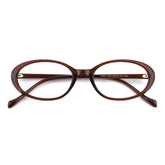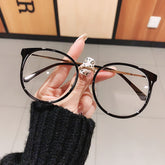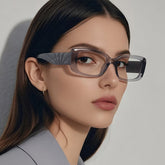What Is Presbyopia?
As we age, our bodies undergo various changes—some more noticeable than others. One common age-related change that affects nearly everyone after the age of 40 is presbyopia. If you’ve found yourself holding books or menus farther away to read them clearly, you might be experiencing this condition.
- What are the characteristics of presbyopia?
- What causes presbyopia?
- What are common signs of presbyopia?
- What are presbyopia's influencing factors?
- Can presbyopia be prevented?
- How to correct presbyopia?
1. What are the characteristics of presbyopia?
Presbyopia is a natural part of aging where the eye gradually loses its ability to focus on nearby objects. Unlike other refractive errors (like nearsightedness or farsightedness), presbyopia is caused by age-related changes in the eye’s lens and muscles, not by the shape of the eyeball.
Presbyopia vs. Hyperopia (Farsightedness)
|
Feature |
Presbyopia |
Hyperopia |
|
Onset |
40+ |
Present at birth, may worsen with age |
|
Cause |
Aging lens |
Eyeball too short or cornea too flat |
|
Near Vision |
Blurred after 40 |
Blurred at all ages (if uncorrected) |
|
Distance Vision |
Usually remains clear |
Clear in mild cases, blurred in severe cases |
|
Focus Mechanism |
Lens can't adjust for near objects |
Eye can't focus light properly on retina |
|
Correction |
Reading glasses, bifocals surgery |
Convex (+) lenses for all distances |
Key Difference: Hyperopia makes near vision blurry at any age, while presbyopia starts after 40. A hyperopic person may develop presbyopia earlier.
Presbyopia vs. Myopia(Nearsightedness)
|
Feature |
Presbyopia |
Myopia |
|
Onset |
40+ |
Childhood/teens |
|
Cause |
Aging lens |
Eyeball too long or cornea too steep |
|
Near Vision |
Blurry (after 40) |
Clear (unless very high myopia) |
|
Distance Vision |
Clear |
Blurry |
|
Focus Mechanism |
Lens can't adjust for near objects |
Light focuses in front of retina |
|
Correction |
Reading glasses, bifocals |
Concave (-) lenses |
Key Difference: Myopes often delay needing reading glasses because their natural nearsightedness compensates for presbyopia.
2. What causes presbyopia?
The eye’s lens is normally soft and flexible, allowing it to change shape to focus light onto the retina. However, as we age, the eye's lens hardens, making it difficult to adjust for close-up vision. This condition typically begins in the early to mid-40s and progresses until around age 65.
3. What are common signs of presbyopia?
- Arm’s-length reading: Instinctively holding things farther away to see them clearly (a classic sign of presbyopia).
- Blurry near vision: Difficulty reading small print (books, phone screens, labels, menus).
- Eye strain and discomfort: Headaches after reading, sewing, or screen use.
- Need for brighter light: Difficulty seeing in low light.
- Difficulty shifting focus: Slow adjustment when looking from near to far (e.g., from a book to a TV across the room).
4. What are presbyopia's influencing factors?
- Age (primary risk factor): Most people begin noticing presbyopia between ages 40–45. Symptoms worsen gradually, with most needing reading glasses by age 50–55.
- Pre-existing refractive errors: Farsighted people may experience presbyopia earlier since the eye already struggles with near focus. Nearsightedness may still need reading glasses but might see better up close without them. Astigmatism doesn’t directly cause presbyopia but can complicate near vision correction.
- Medical conditions: Diabetes can accelerate lens hardening. Multiple sclerosis, cardiovascular disease, or anemia may worsen focusing ability. Eye conditions like cataracts or macular degeneration can compound vision problems.
- Medications that affect focus: Antihistamines, antidepressants, and diuretics may cause temporary near-vision blur. Blood pressure medications and steroids can impact eye muscle function.
- Lifestyle and environmental factors: Excessive near work doesn’t cause presbyopia but can make symptoms more noticeable. UV exposure and smoking may contribute to early lens aging. Poor nutrition, low in antioxidants and vitamins A, C, and E, may affect lens health.
5. Can presbyopia be prevented?
No. Since presbyopia is caused by natural aging of the eye's lens, it cannot be fully prevented. However, good eye health habits (UV protection, healthy diet, regular eye exams) can help maintain overall vision.
What may help?
- Wear sunglasses (100% UV protection) to slow lens aging. Because chronic UV exposure may accelerate lens hardening.
- Eat antioxidant-rich foods (leafy greens, berries, and fish) to support lens clarity. Stay hydrated (dry eyes worsen presbyopia symptoms). Control diabetes and hypertension (poor circulation affects eye function).
- Take regular screen breaks (20-20-20 rule: every 20 mins, look 20 feet away for 20 sec). Use proper lighting for reading (avoid glare and shadows). Adjust screen font size/brightness to minimize squinting.
- Get regular eye exams (especially after age 40). After age 40, get annual checkups to monitor changes.
What doesn’t work?
- Eye exercises (can’t restore lens flexibility).
- Special diets or supplements (won’t reverse hardening of the lens).
- Avoiding reading/close work (presbyopia happens regardless).
Even with perfect habits, presbyopia will eventually develop (usually 40s–50s). The goal isn’t prevention but delaying severe symptoms and finding the best correction.
6. How to correct presbyopia?
While presbyopia can’t be prevented, several correction options are available:
1. Eyeglasses
- Reading glasses: They are used only for close-up tasks.
- Bifocals: Glasses have two lens powers (distance and near vision).
- Progressive glasses: They are multifocal glasses without visible lines, offering a smooth transition between distances.
- Multifocal contacts provide different zones for near and far vision.
- Monovision contacts: One eye is corrected for distance, the other for near vision.
3. Surgical Treatments
- LASIK (monovision correction) adjusts one eye for near vision.
- Refractive lens exchange (RLE) replaces the natural lens with a multifocal implant.
4. Lifestyle and Supportive Care
- Use brighter lighting for reading.
- Use the magnifying tools (e.g., smartphone zoom, handheld magnifiers).
- Follow the 20-20-20 rule (every 20 mins, look 20 feet away for 20 sec to reduce eye strain).
Presbyopia is a normal part of aging, and with the right corrective measures, it doesn’t have to interfere with daily life. If you’re experiencing symptoms, a suitable pair of glasses is enough to meet your vision needs.











